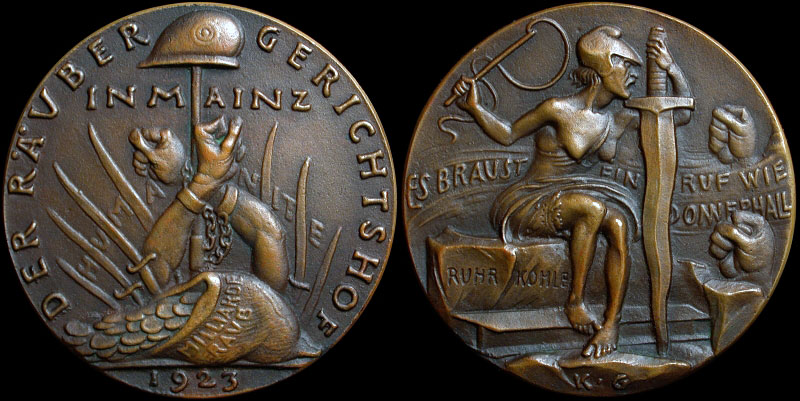 |
||||||||||||||||
|
K-296
|
||||||||||||||||
|
THE ROBBERS COURT
|
||||||||||||||||
|
(Räubergerichtshof in Mainz) |
||||||||||||||||
|
1923, Cast bronze, Satirical medal, 61.5mm, 74.30g., Edge-punched, "KGoeTz".
|
||||||||||||||||
|
------------
|
||||||||||||||||
|
Obverse: "Humanite" (Humanity) is represented by two arms shackled to a pole with an assault helmet resting on top and all surrounded by sabers. A bag of stolen money marked "Milliarde raub" (Robbery of Billions) lies in the foreground. Inscription reads, "Der Raubergerichtshof in Mainz" (The Robber Court in Mayence), Dated 1923 in exergue. Reverse: A rather wicked and partly naked Marianne guards her "Ruhr Kohle" (Ruhr coal) with whip and huge sword. Two clenched fists represent German resistance. Inscription in background from an old patriotic song, "Es braust ein Ruf wie Donnerhall-" (There roars a call with thundering echo-). K•G in exergue formed by coal deposit. |
||||||||||||||||
|
------------ Germany was held in willful default in the discharge of reparation payments. France claimed that 100,000 telegraph poles were not delivered and later a delivery of coal was not made. These were enough reasons for the Reparation Commission to sanction the occupation of German territory. French and Belgian troops (5 French Divisions and 1 Belgian Division) marched into the Ruhr Valley, the center of German industry. The German government under Chancellor Cuno declared the tactic of passive resistance towards the occupation forces. The French countered by declaring martial law and confiscating all funds of the Reichsbank, other public banks, and many private accounts. When the management of the Krupp Works in Essen ordered their employees to exercise passive resistance tactics on Easter 1923 (not giving a hand to the French troops who came to pick-up automobiles under the reparation terms) Krupp von Bohlen und Halbach and eight of his leading directors are put before a French war tribunal. The convictions ranged from ten to fifteen years each in prison and each had to pay 100 million marks in penalty money. This medal reflects reference to these times. ------------ |
||||||||||||||||